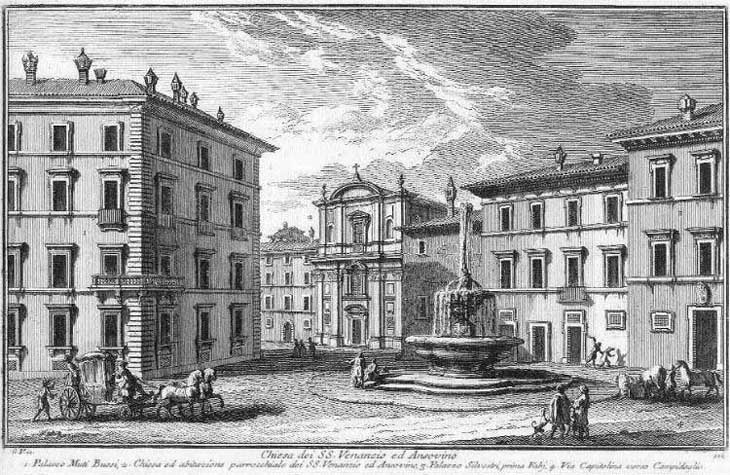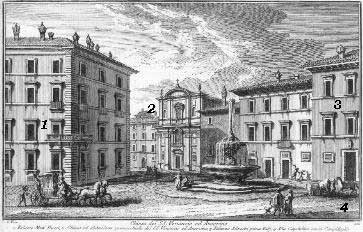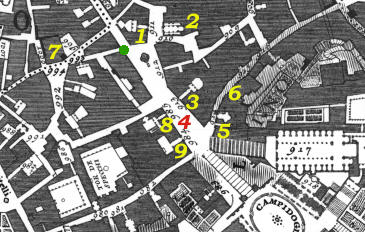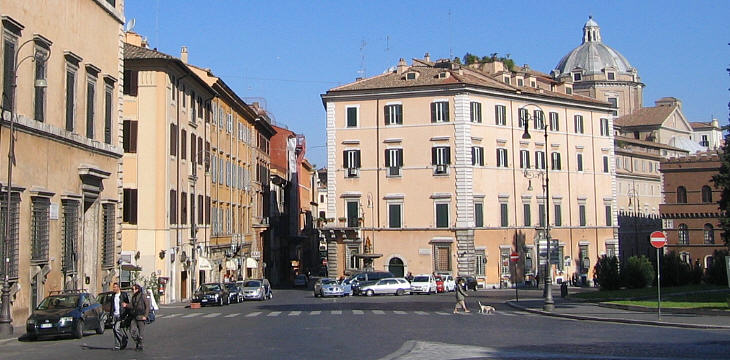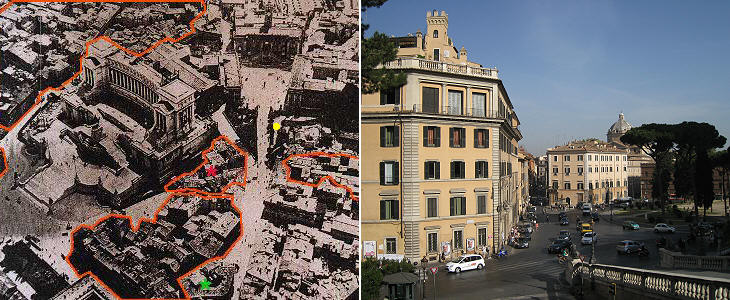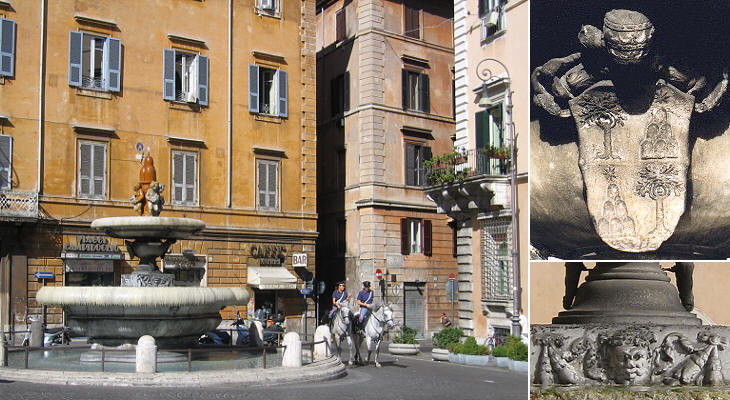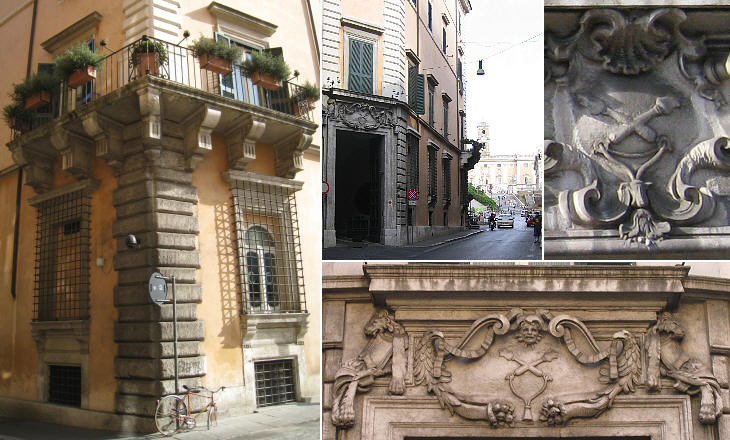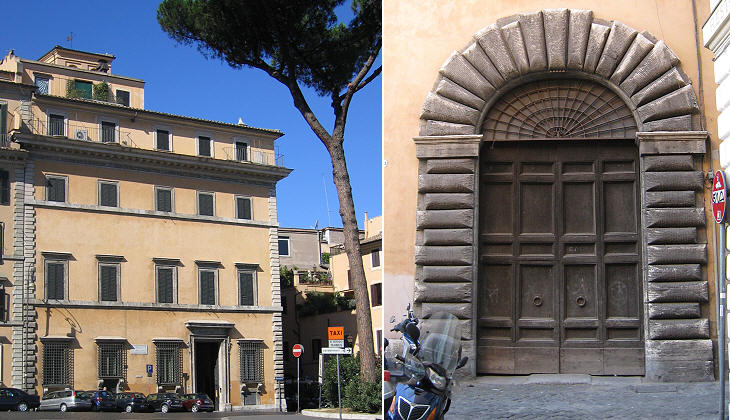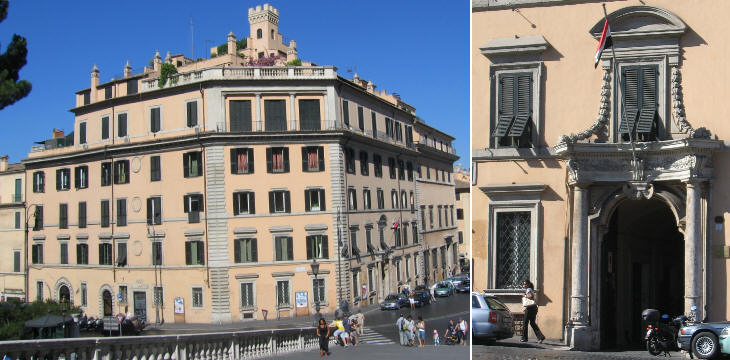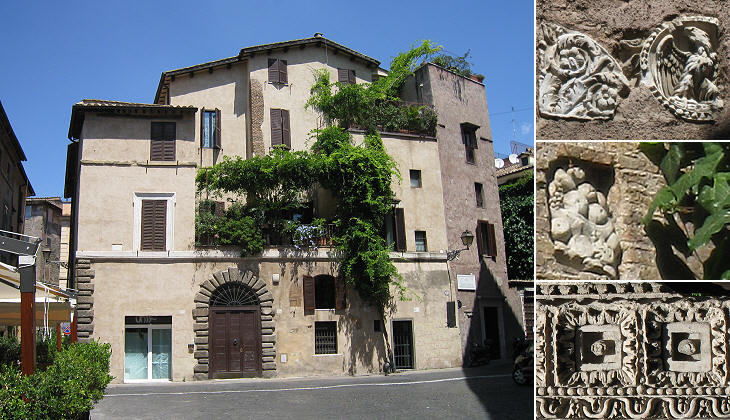  What's New! Detailed Sitemap All images © by Roberto Piperno, owner of the domain. Write to romapip@quipo.it. Text edited by Rosamie Moore. Page revised in October 2009. | SS. Venanzio e Ansovino (Book 6) (Day 1) (View C8) (Rione Campitelli), (Rione Pigna) and (Rione Sant'Angelo)
In this page:
The etching shows Piazza d'Aracoeli, a small square along the street linking il Ges¨ with S. Maria d'Aracoeli and Palazzi del Campidoglio. It has the three elements of an Italian piazza: a church, a palace and a fountain. The view is taken from the green dot in the small 1748 map here below. In the description below the plate Vasi made reference to: 1) Palazzo Muti Bussi; 2) SS. Venanzio ed Ansovino; 3) Palazzo Silvestri; 4) Via Capitolina leading to Campidoglio. The small map shows also: 5) S. Rita da Cascia; 6) Casa di Pietro da Cortona; 7) Tor Margana; 8) Palazzo Fani; 9) Palazzo Massimo. The dotted line in the small map delineates the border between Rione Pigna (upper part), Rione Sant'Angelo (small part on the left) and Rione Campitelli.
Today
The church and the adjoining buildings (including Palazzo Silvestri) were pulled down in 1928 to make room for a large square surrounding the Monument to Victor Emmanuel II and for the opening of Via del Mare, a new road linking the centre of Rome with the southern part of the city.
SS. Venanzio and Ansovino was a small medieval church which was redesigned by Giovanni Battista Contini in the late XVIIth century when the church was assigned to the community of inhabitants of Camerino who lived in Rome (Camerino is a small town in the Marche region - see a list of churches belonging to foreign communities). The house of Pietro da Cortona is among the lost buildings of this part of Rome. S. Rita da Cascia, another small church which was pulled down at the same time as SS. Venanzio and Ansovino, was rebuilt near Teatro di Marcello. The Fountain of Pope Sixtus V
The fountain was built in 1589 by Giacomo della Porta as part of a large plan for the distribution of Acqua Felice, the water carried by an aqueduct built by Pope Sixtus V. The three mountains at the top of the fountain are a reference to the heraldic symbol of that pope. The coats of arms of Pope Alexander VII celebrate a restoration of the fountain. Palazzo Muti Bussi
The Muti family claimed to descend from Mutius Scaevola, so when Cecilia Muti, the last of the family, married a Bussi, her father insisted that Muti be added to Bussi (because of its greater lustre Muti was named first). Palazzo Muti Bussi is a late XVIIth century work by Giovanni Antonio De' Rossi. The portals are decorated with the heraldic symbols of the Muti, in particular a couple of maces (clubs with a metal head and spikes); these are called mazze in Italian and they were therefore a reference to Mutius Scaevola. You may wish to see the fine monuments to Giovanni Andrea Giuseppe Muti and his wife Maria Colomba Vincentini in the church of S. Marcello. Palazzo Fani
The palace is now usually called Palazzo Pecci Blunt after the current owners. It belonged to many Roman families including the Ruspoli and the Spada. However it is during the Fani family ownership at the end of the XVIth century that the building was redesigned by Giacomo della Porta. It has a very fine loggia. Palazzo Massimo
In 1939 the eastern corner of the building was cut to enlarge the street. As a result the balcony at the attic level enjoys a terrific view over the twin steps leading to Piazza del Campidoglio and S. Maria d'Aracoeli. The loggia in the form of a little castle is a XIXth century addition. Apart from these changes the palace retains the appearance it was given in 1695 when Carlo Fontana redesigned it. The elegant portal became a pattern for the architects of the XVIIIth century. The palace currently (2009) houses the Embassy of Syria. Tor Margana
In the XVth century the Margani were often involved in fights with other Roman families. The chronicles of the time report a Paolo Margano killing a Bartolomeo Santacroce in 1446 and another Paolo Margano killing a Prospero Santacroce in 1485. The Santacroce lived very near in their fortified palace and the two families were fierce enemies. The Margani had a fortified house too, which they embellished with true and fake fragments of Roman buildings. Today Piazza di Tor Margana is one of the most peaceful squares of Rome. Excerpts from Giuseppe Vasi 1761 Itinerary related to this page:
Next plate in Book 6: S. Maria in Campitelli Next step in Day 1 itinerary: S. Maria in Aracoeli Next step in your tour of Rione Campitelli: S. Maria in Campitelli Next step in your tour of Rione Sant'Angelo: Palazzo Paluzzi Serlupi Lovatelli |
